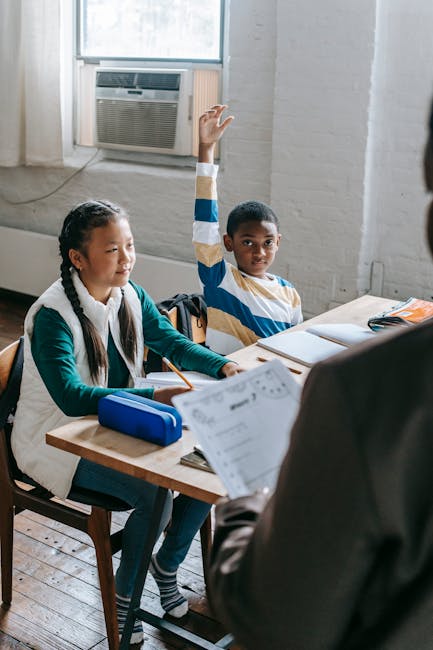Are you tired of trying to cram information into your brain through boring old textbooks and lectures? Well, fear not, my fellow knowledge seekers! Today, we’re going to dive into the wonderful world of learning styles and discover the magical realms of visual, auditory, and kinesthetic learning. So grab your goggles, earmuffs, and trampoline, because we’re about to take your brain on a wild and wacky adventure through the land of education!
Overview of Learning Styles
Ever wonder why some people seem to breeze through learning new information while others struggle? It could be because of their learning style! Understanding your learning style can help you better absorb information and improve your study habits. Let’s take a closer look at the different types of learning styles:
- Visual Learners: Visual learners prefer to see information displayed in charts, graphs, or diagrams. They have a keen eye for detail and often benefit from using color coding to organize their notes. If you’re a visual learner, you might find it helpful to watch videos or use flashcards to enhance your learning.
- Auditory Learners: Auditory learners excel at absorbing information through listening. They may enjoy listening to podcasts, participating in group discussions, or even talking to themselves while studying. If you’re an auditory learner, try recording your notes and listening to them on repeat to reinforce your understanding.
- Kinesthetic Learners: Kinesthetic learners learn best through hands-on experiences and physical activities. They often benefit from taking study breaks to move around, engaging in role-playing exercises, or using practical examples to grasp concepts. If you’re a kinesthetic learner, don’t be afraid to get your hands dirty (figuratively speaking) while learning!
Knowing your learning style can help you tailor your study methods to suit your individual needs. Experiment with different techniques and strategies to discover what works best for you. Remember, there’s no one-size-fits-all approach to learning, so embrace your unique style and keep striving for success!

Visual Learners: Understanding Their Needs
Visual learners are a unique breed of individuals who thrive in a world filled with bright colors, engaging graphics, and eye-catching visuals. These learners have a special knack for soaking up information when it is presented to them in a visually stimulating way. If you want to cater to the needs of visual learners, here are a few things you should keep in mind:
- Colorful Charts and Graphs: Visual learners love to see information presented in a colorful and easily digestible format. Utilize charts and graphs in your presentations and materials to help them better understand complex concepts.
- Interactive Tools: Give visual learners the opportunity to interact with the material. Whether it’s through online quizzes, virtual simulations, or hands-on activities, they will appreciate the chance to engage with the content in a more tactile way.
- Visual Storytelling: Instead of just presenting facts and figures, try to weave a story into your lessons. Visual learners respond well to narratives and will be more likely to retain information if it is presented in a compelling and engaging way.
Remember, visual learners are a creative and imaginative bunch who thrive on visual stimuli. By catering to their unique needs, you can help them reach their full learning potential and make your lessons more engaging and effective for everyone.

Auditory Learners: Maximizing Their Potential
For auditory learners, the world is their oyster when it comes to maximizing their potential. They thrive off of listening and absorbing information through sound, making them the ultimate podcast enthusiasts and karaoke champions.
One way to really amp up their learning experience is by incorporating music into their study routine. Whether it’s classical tunes to focus or upbeat jams to energize, creating a soundtrack for their study sessions can help auditory learners retain information better.
Another tip for auditory learners is to participate in group discussions and debates. By engaging in conversations with others, they can bounce ideas off of each other and truly immerse themselves in the learning process.
Lastly, incorporating storytelling and verbal presentations into their learning can really bring out the best in auditory learners. By having them share their knowledge through speeches or creative retellings of information, they can solidify their understanding and showcase their unique skills.

Kinesthetic Learners: Embracing Hands-On Learning
Do you find yourself fidgeting in your seat during long lectures? Are you constantly doodling in your notebooks? Well, you might just be a kinesthetic learner! Embracing hands-on learning is the key to success for those who thrive on movement and touch.
So how can you make the most of your unique learning style? Here are some tips:
- Get up and move around during study sessions – take a walk, do some jumping jacks, or even dance to your favorite song!
- Use hand gestures to help you remember important information – the bigger, the better!
- Try incorporating tactile tools into your learning, like stress balls, fidget toys, or even Play-Doh.
Remember, it’s all about finding what works best for you. Don’t be afraid to think outside the box (or classroom) when it comes to embracing hands-on learning!

Utilizing Multiple Learning Styles in Education
Who said learning can’t be fun? By incorporating various learning styles, educators can keep students engaged and excited about learning. Let’s mix things up in the classroom and cater to different types of learners!
Visual learners, rejoice! Get ready to feast your eyes on colorful graphics, diagrams, and charts. Say goodbye to boring blackboards and hello to interactive whiteboards. **Visual aids** are your new best friend in understanding complex concepts.
For all you auditory learners out there, get ready to rock out with some educational podcasts and audiobooks. Let the power of sound lead you to success! Don’t be afraid to ask your teacher to explain a concept out loud, multiple times if needed. **Verbal instructions** are music to your ears!
Tactile and kinesthetic learners, it’s time to get hands-on! Leave the textbooks behind and dive into interactive activities. Build models, conduct experiments, and engage in role-playing scenarios. Let your body take the lead in absorbing knowledge. Embrace the power of **physical engagement**!
Strategies for Tailoring Teaching Methods to Different Learners
When it comes to tailoring teaching methods to different learners, it’s important to remember that not all students learn in the same way. Here are some strategies to help you reach every student in your classroom:
- Visual Learners: For those students who thrive on visual cues, consider incorporating diagrams, charts, and graphics into your lessons. Encourage them to create mind maps or doodle while they listen.
- Auditory Learners: These students learn best through listening. Try incorporating podcasts, music, and verbal instructions into your teaching. Encourage them to read aloud or participate in discussions.
- Kinesthetic Learners: For students who learn best through hands-on activities, use interactive demonstrations, role-playing exercises, and physical movement in your lessons. Encourage them to participate in experiments or simulations.
Remember, variety is key when it comes to catering to different learning styles. Be flexible and willing to adapt your teaching methods to meet the needs of all your students. By incorporating a mix of visual, auditory, and kinesthetic elements into your lessons, you can ensure that everyone has the opportunity to succeed.
benefits-of-embracing-diverse-learning-styles”>Benefits of Embracing Diverse Learning Styles
Have you ever wondered why some people are visual learners while others are more hands-on? Well, that’s because everyone has their own unique learning style! Embracing diverse learning styles allows for a more inclusive and engaging educational experience for everyone involved. So, let’s explore some of the benefits of catering to different ways of learning:
For starters, **variety** is the spice of life, right? No one wants to be stuck in a monotonous lecture that only caters to one type of learner. By embracing diverse learning styles, we can keep things fresh and exciting for everyone involved. Whether it’s through visual aids, hands-on activities, or group discussions, there’s something for everyone to enjoy.
Another great advantage of embracing diverse learning styles is **fostering creativity**. By allowing students to learn in a way that suits them best, we’re encouraging them to think outside the box and approach problems from different angles. Who knows, the next Einstein might just be a kinesthetic learner who thrives on hands-on experimentation!
Lastly, embracing diverse learning styles can **improve retention**. When students are able to engage with the material in a way that resonates with them personally, they’re more likely to remember it long-term. So, whether you’re a visual learner who loves graphs and charts, or an auditory learner who absorbs information through music and podcasts, there’s a way for everyone to succeed.
FAQs
What does it mean to have a visual learning style?
Having a visual learning style means you learn best through visual aids such as diagrams, charts, and videos. You probably have a knack for remembering things you’ve seen rather than heard.
How can someone with an auditory learning style improve their study habits?
For all you auditory learners out there, try listening to recorded lectures or turning your notes into songs. Just imagine acing that exam while jamming out to your own educational mixtape!
What activities can help someone with a kinesthetic learning style retain information?
If you’re a kinesthetic learner, consider acting out scenarios or using physical objects to represent concepts. Who says learning can’t involve a little dance party or some hands-on activities?
—
Time to Embrace Your Inner Learning Style
And there you have it! Whether you’re a visual learner who loves to see information visually, an auditory learner who thrives on listening and discussing, or a kinesthetic learner who learns best by doing, it’s time to embrace your unique learning style. Don’t be afraid to experiment with different ways of learning and remember, it’s okay to ask for help or clarification if you’re struggling. With a little creativity and a lot of humor, you’ll be on your way to mastering new skills and knowledge in no time! Happy learning!






